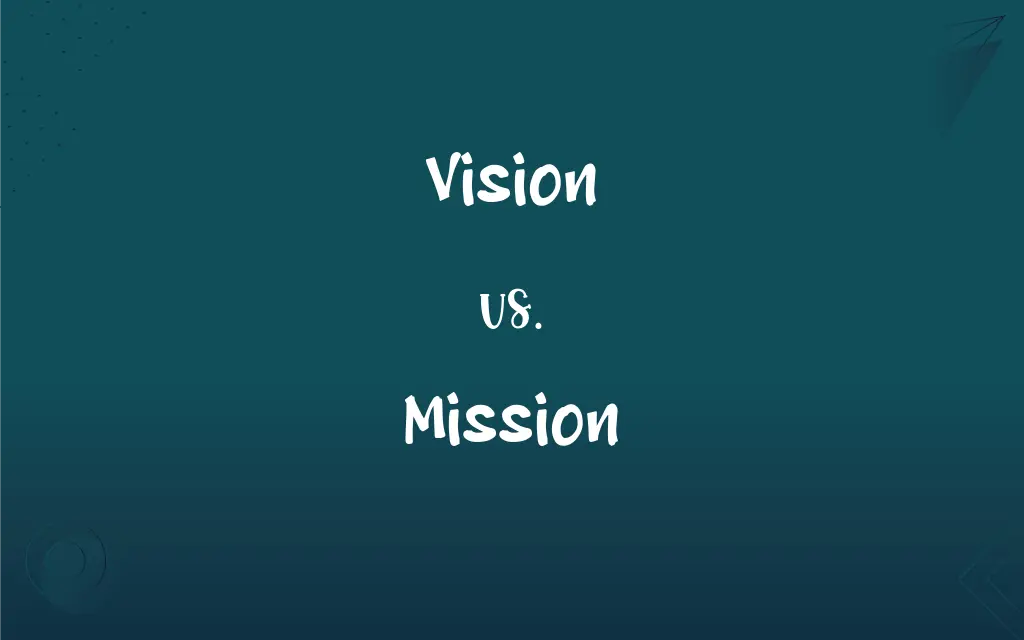Vision vs. Mission: What's the Difference?
Edited by Janet White || By Harlon Moss || Updated on October 20, 2023
A vision outlines a company's long-term aspirations, while a mission defines its current purpose and objectives.

Key Differences
A vision represents an organization's future aspirations. It provides a long-term picture of what the organization hopes to achieve or become. This overarching goal serves as a guiding star, steering the company's strategic decisions and setting its trajectory. Mission, on the other hand, centers on the organization's present. It defines why the organization exists and the specific goals it's currently pursuing.
In many ways, a vision is the dream or the "what" of an organization. It portrays an ideal future state that the organization hopes to attain. This forward-looking statement typically remains consistent over time, only changing when the organization undergoes major transformations. The mission, however, is the "how." It pinpoints the actions and strategies the organization uses to achieve its vision. The mission is actionable and can be more tangible, guiding day-to-day operations.
Understanding both vision and mission is crucial for stakeholders. The vision offers a sense of direction, inspiring employees, shareholders, and even customers about the organization's long-term plans. It motivates and challenges them to work towards that future. In contrast, the mission offers clarity. It delineates the organization's core values, purpose, and immediate goals, ensuring everyone is aligned in their daily tasks.
To encapsulate, while vision and mission are two sides of the same coin, they serve distinct roles. The vision dreams and inspires, painting a picture of the future. Meanwhile, the mission defines and directs, grounding the organization in its current reality and steps toward its vision.
Comparison Chart
Focus
Future aspirations
Current objectives
ADVERTISEMENT
Duration
Long-term
Short to mid-term
Nature
Abstract, inspirational
Concrete, actionable
Change Frequency
Rarely changes
Might evolve with organizational shifts
Role
Provides direction
Defines purpose and tasks
Vision and Mission Definitions
Vision
A picture of an organization's desired future.
Google's vision is to organize the world's information and make it universally accessible.
ADVERTISEMENT
Mission
The actions and strategies to achieve a vision.
His mission was to empower local artisans through training.
Vision
An aspirational goal for the distant future.
His vision was of a world without poverty.
Mission
A statement that guides an entity's day-to-day operations.
The school's mission is to provide holistic education for all children.
Vision
A long-term outlook on what success looks like.
The company's vision is to be the industry leader within a decade.
Mission
Defines the present role of an organization.
Their mission is to provide affordable healthcare for everyone.
Vision
The dream or ultimate objective of an entity.
Her vision for the community was one of harmony and collaboration.
Mission
A concise articulation of an organization's raison d'être.
The startup's mission was to revolutionize the way we use energy.
Vision
An inspiring depiction of a future state.
The NGO's vision was a planet where all species thrived.
Mission
An organization's core purpose and objectives.
The NGO's mission is to conserve endangered species.
Vision
The faculty of sight; eyesight
Poor vision.
Mission
A special assignment given to a person or group
An agent on a secret mission.
Vision
Something that is or has been seen.
FAQs
How is a mission statement typically used?
A mission guides an organization's current actions, strategies, and objectives.
Which is more long-term, vision or mission?
The vision is more long-term, while the mission focuses on short to mid-term objectives.
What does a vision represent?
A vision portrays an organization's long-term aspirations or desired future state.
Is a vision statement necessary for all organizations?
While beneficial, not all organizations might have a formal vision statement, but they likely have an informal understanding of their future aspirations.
Can a company have multiple vision statements?
While a company might have various objectives, it usually has one overarching vision that guides its future direction.
What comes first, vision or mission?
The vision, as a long-term goal, generally precedes the mission, which outlines how to achieve that vision.
Can an individual have a personal vision?
Absolutely. Many individuals set a personal vision to guide their long-term life goals.
Who decides an organization's mission?
Typically, top leadership or founders decide the mission, but it can involve input from various stakeholders.
Should a mission be customer-centric?
While not mandatory, many organizations craft a mission keeping their customers' needs and values in mind.
How can a company ensure its mission is effective?
An effective mission is clear, aligns with organizational values, is actionable, and resonates with stakeholders.
Why is having a clear vision important?
A clear vision provides direction, inspires stakeholders, and sets the organization's long-term trajectory.
How often should a company revisit its mission?
While there's no set rule, companies should revisit their mission periodically to ensure alignment with their current objectives and values.
Is the vision statement actionable?
Typically, the vision is aspirational and not directly actionable. The mission offers actionable steps towards the vision.
How detailed should a mission statement be?
A mission should be concise yet provide clarity on the organization's current purpose and objectives.
Should employees be aligned with the company's mission?
Yes, employees should understand and align with the company's mission to ensure cohesive effort and direction.
How do vision and mission relate to values?
While vision and mission guide direction and purpose, values define the principles guiding how an organization operates.
Can an organization's mission change over time?
Yes, a mission can evolve as an organization grows or changes direction.
How is vision different from a goal?
While a goal is a specific target, a vision is a broader aspirational depiction of the future.
Why might a company revise its vision?
Significant changes, like mergers, market shifts, or new leadership, might prompt a company to revise its vision.
Can a vision change?
While vision is long-term, significant organizational transformations might lead to its revision.
About Author
Written by
Harlon MossHarlon is a seasoned quality moderator and accomplished content writer for Difference Wiki. An alumnus of the prestigious University of California, he earned his degree in Computer Science. Leveraging his academic background, Harlon brings a meticulous and informed perspective to his work, ensuring content accuracy and excellence.
Edited by
Janet WhiteJanet White has been an esteemed writer and blogger for Difference Wiki. Holding a Master's degree in Science and Medical Journalism from the prestigious Boston University, she has consistently demonstrated her expertise and passion for her field. When she's not immersed in her work, Janet relishes her time exercising, delving into a good book, and cherishing moments with friends and family.































































